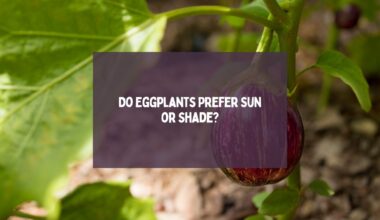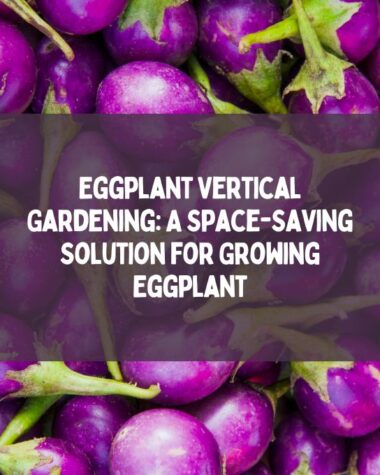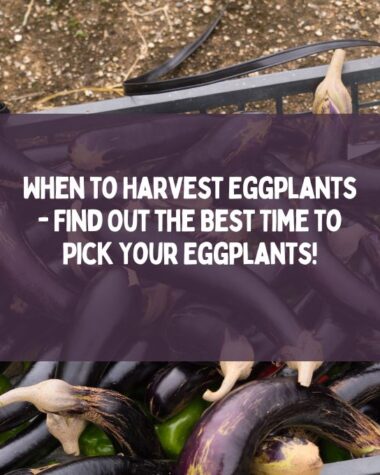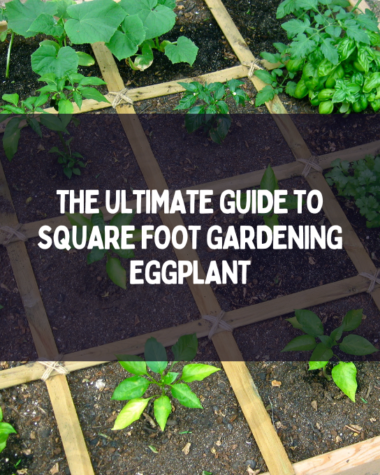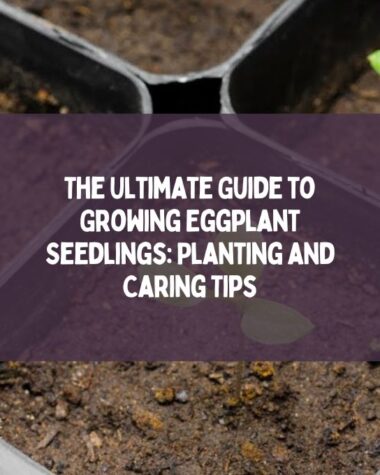To grow eggplant in a pot, you can start by choosing a large pot with drainage holes and filling it with a nutrient-rich potting mix. Plant the eggplant seeds in the pot with appropriate space. Place the pot in a sunny location and water the plants, keeping the soil moist but not waterlogged.
Growing eggplant in a pot is a rewarding way to enjoy this versatile vegetable, even if you have limited garden space. Eggplants thrive in warm climates and require well-drained soil, adequate sunlight, and regular watering. With regular fertilization and pruning, you can successfully grow healthy and delicious eggplants in a pot.
In this article, I will explain how to grow eggplant in containers, the proper care steps, and the varieties of eggplant that are suitable to grow in containers.
Let’s Start.
How To Grow Eggplant In Pots?

Yes, eggplants can be successfully grown in pots, making them a suitable option for container gardening.
The main steps to growing eggplants in containers are given below:
1. Choose The Large Pot For Eggplants
When choosing a pot for growing eggplants, always choose a large container with a capacity of at least 5 gallons. Eggplants have an extensive root system, so a spacious pot will allow the roots to spread and grow properly.
Look for a pot with drainage holes at the bottom to prevent waterlogging, as excessive moisture can lead to root rot. Consider using a pot made of a durable material such as plastic.
The pot should be deep enough to accommodate the eggplant’s root depth and wide enough to provide space for the plant to grow and develop.
2. Choose The Best Eggplant Variety
When selecting a variety of eggplant to grow in a pot, it’s important to choose a compact and bushy variety that is well-suited for container gardening. Look for dwarf or patio varieties specifically bred for small spaces.
Some recommended varieties for pots include ‘Black Beauty,’ ‘Fairy Tale,’ ‘Ichiban,’ and ‘Pingtung Long.’ These varieties have compact growth habits, shorter heights, and smaller fruit sizes, making them ideal for container gardening.
Consider choosing disease-resistant varieties to ensure the health and productivity of your plants. Research and select a variety that suits your preferences and growing conditions to maximize the success of growing eggplant.
Related Reading
- Where Do Aubergines Grow Naturally?
- Guide On Eggplant Life Cycle: From Seed Germination To Harvesting And Storing
- White Shades Of Eggplant: Exploring the Versatility of White Eggplant
- What’s the Best Way to Cook Eggplant?
3. Plant The Seeds
To plant eggplant seeds in a pot, start by filling the pot with a well-draining potting mix. Moisten the soil slightly before sowing the seeds. Place the seeds on top of the soil, spacing them about half an inch to an inch apart.
Gently press the seeds into the soil; make sure they are covered with a thin layer of soil, approximately half an inch deep. Keep the soil consistently moist, but avoid overwatering, as it can lead to fungal issues.
Once the seedlings have emerged, thin them out if necessary, leaving the strongest ones spaced adequately apart.
Care For Eggplants in Pots
Proper care is essential for healthy eggplant plants. Provide well-drained soil, sunlight, and regular watering. Use organic matter and balanced fertilizers to nourish the plants. Support them with stakes or cages to prevent breakage.
Assist in pollination by shaking or brushing flowers. Monitor for pests and diseases and take appropriate action. Prune to promote airflow and remove damaged parts. Harvest when the fruits are ready to be picked.
4. Fertilizers
To ensure healthy growth and abundant yields, start by incorporating organic matter, such as compost or well-rotted manure, into the potting mix before planting. Once the plants have established themselves, apply a balanced, slow-release fertilizer according to the package instructions.
Supplement with a water-soluble fertilizer every two to three weeks during the growing season to boost growth and productivity. Avoid over-fertilization, as it can lead to excessive foliage growth and fewer fruits.
5. Provide Adequate Sunlight
Choose a sunny location for your pot where the plants can receive at least six to eight hours of direct sunlight daily. Place the pot in a spot that receives sunlight throughout the day, such as a south-facing balcony.
If you have limited access to direct sunlight, consider using reflective surfaces or mirrors to redirect the available sunlight onto the plants. Also, you can use artificial light bulbs to provide heat to the eggplants. Make sure the eggplants receive the maximum amount of sunlight for optimal growth, flowering, and fruiting.
6. Water Regularly
Regular watering is necessary for the healthy growth of eggplants. Keep the soil moist but avoid waterlogging, as it can lead to root rot. Check the moisture level of the soil regularly by inserting your finger about an inch deep into the soil.
If it feels dry, it’s time to water it. Provide thorough watering, allowing the water to drain out of the pot’s drainage holes. Ensure that the pot has proper drainage to prevent water accumulation. You can also use a drip irrigation system to water the plants.
During hot and dry weather, you may need to water your eggplants more frequently. Protect your plants from overwatering, as it can lead to fungal infections.
7. Support The Plants
Supporting your eggplant plants in a pot will prevent them from breaking under the weight of their fruits. As the plants grow, install stakes or cages in the pot to provide support. Place the stakes or cages when the plants are young to avoid damaging the roots later.
Gently tie the main stem or branches to the stakes using plant ties. As the plant grows taller, continue to tie heavy branches to the support structure. Supporting will promote upright growth, improve air circulation, and facilitate the development of healthy and abundant fruit.
8. Pollination
Pollination plays a crucial role in the successful fruit set of eggplants grown in pots. Eggplants are typically self-pollinating, meaning they have both male and female flowers on the same plant.
However, to ensure optimal pollination, it’s beneficial to provide assistance. Gently shake the plants or use a small brush to transfer pollen between the flowers. This helps to ensure that the pollen reaches the stigma and facilitates the fertilization process.
Encouraging pollinators such as bees and butterflies to visit your garden can enhance natural pollination. That’s how you can maximize the fruit production and yield of your eggplant plants in pots.
Harvesting Eggplants in Pots

Harvesting eggplants from your potted plants is an exciting and rewarding part of the growing process. Wait until the fruits have reached their mature size, typically 6–8 inches in length, and have a firm skin.
Using a sharp knife or garden shears, carefully cut the eggplants from the plant, leaving a short stem attached. Avoid pulling or twisting the fruit, as this can damage the plant. Harvest regularly to encourage continuous production.
Overripe or overgrown eggplants may develop a bitter taste, so it’s best to harvest them promptly. Enjoy the fresh, flavorful eggplants in your favorite recipes and savor the fruits of your labor.
Other Factors To Look While Growing Eggplant In Pots
The factors that play important role during growing eggplants in containers are given below;
Mulching Techniques
Mulching is a beneficial technique for growing eggplants in pots, as it helps to conserve moisture, regulate soil temperature, suppress weed growth, and improve overall plant health. After planting the eggplants in the pot, apply a layer of organic mulch, such as straw, wood chips, or compost, around the base of the plants.
Make sure to leave a small space around the stem to prevent moisture accumulation and potential rot. The mulch layer should be around 2-3 inches thick. This will help retain moisture in the soil, reduce the need for frequent watering, and provide a protective barrier for the roots.
Pruning And Removing Suckers
Pruning and removing suckers are important practices for maintaining healthy and productive eggplant plants in pots. Suckers are the small side shoots that emerge from the leaf axils of the plant.
To encourage a strong central stem and better airflow, it is recommended to pinch off these suckers when they are young. This helps the plant direct its energy towards fruit production rather than excessive foliage growth.
Regularly prune the eggplant plants by removing any damaged or diseased leaves or branches. It helps control the size and shape of the plan. Use clean and sharp pruning shears to minimize damage to the plant.
Propagating Eggplant
Propagating eggplant in pots can be done through two methods:
- Seed Propagation
- Stem Cuttings
To propagate from seeds, collect mature fruits and extract the seeds. Sow them in seed trays or small pots filled with well-draining potting mix.
Keep the soil moist and provide adequate warmth and light for germination. Propagating through stem cuttings involves selecting healthy, non-flowering stems from an existing plant.
Cut a 4-6-inch section below a leaf node and remove the lower leaves. Dip the cut end in a rooting hormone and plant it in a pot with moist soil. Provide a warm and humid environment until new roots develop.
Pests And Diseases
When growing eggplants in pots, it’s important to be vigilant against common pests and diseases. Common pests include aphids, whiteflies, and flea beetles. Regularly inspect the plants and use organic insecticidal soaps or neem oil to control infestations. Diseases such as fungal infections, bacterial spots, and wilts can also affect eggplants.
Prevention
- Proper air circulation, avoid overwatering, and provide adequate spacing between plants.
- Remove and destroy any infected plant material to prevent the spread of disease.
- Applying a preventive copper-based fungicide can help protect against fungal diseases.
Blossom End Rot
Blossom end rot is a common problem that can affect eggplants grown in pots. Due to inconsistent water uptake or insufficient calcium availability in the soil, this condition results from a calcium deficiency in the developing fruit.
Prevention
- Ensure consistent and adequate watering, avoiding both under- and over-watering.
- Maintain proper soil moisture levels by providing regular, deep watering sessions.
- Consider adding calcium-rich amendments, such as crushed eggshells or agricultural lime, to the soil before planting.
Common Problems During Eggplant Growing in Containers

Here are some common eggplant growing problems in pots.
- Lack of sunlight: Insufficient sunlight can result in stunted growth and poor fruit production. Make sure your eggplant container receives at least six to eight hours of direct sunlight daily.
- Overwatering: Excessive watering can lead to root rot and other fungal diseases. Allow the soil to dry slightly between watering sessions and ensure proper drainage to prevent waterlogging.
- Nutrient deficiencies: Container-grown eggplants may experience nutrient deficiencies due to limited soil nutrients. Regularly fertilize with a balanced fertilizer to provide essential nutrients and maintain plant health.
- Pests: Common pests such as aphids, whiteflies, and flea beetles can damage eggplants. Monitor plants regularly and use organic insecticides.
- Disease susceptibility: Eggplants grown in containers can be prone to fungal diseases like powdery mildew or bacterial infections. Proper air circulation and avoid overcrowding to prevent the spread of diseases.
Eggplant Varieties For Planting In Pots
The popular eggplant varieties are given below:
- Black Beauty: This is a classic variety with large, dark purple fruits. It is known for its mild flavor and tender flesh. Black Beauty is a reliable and widely grown variety.
- Fairy Tale: This variety produces small, elongated fruits with a purple and white striped skin. Fairy Tale eggplants are flavorful and have a creamy texture. They are often harvested when young and tender.
- Pingtung Long: Pingtung Long is a popular Asian variety with long, slim fruits and glossy purple skin. It has a sweet flavor and is often used in stir-fries and grilling. It is heat tolerant and suitable for growing in warm climates.
- Rosa Bianca: This Italian heirloom variety has unique round to teardrop-shaped fruits with pale pink and lavender skin. Rosa Bianca eggplants have a creamy texture and a mild, delicate flavor.
- White Egg: As the name suggests, this variety produces small to medium-sized egg-shaped fruits with a creamy-white skin. White egg eggplants have a tender texture and a slightly sweet flavor. They are ideal for use in various culinary dishes.
These are just a few eggplant varieties mentioned, each with its own unique characteristics and flavors.
Related Reading
- How to Grow Pumpkins in Pots?
- Can We Grow Zucchini And Eggplant Together?
- Kirby Cucumber: A Versatile and Nutritious Addition to Your Kitchen
- Effective Carrot Rust Fly Control: Tips To Combat Rust Fly Maggots
Conclusion
Growing eggplant in a pot can be rewarding and successful if you consider all the necessary factors. Start by choosing a large pot and selecting a compact variety suitable for container gardening. Provide six to eight hours of direct sunlight daily and water them regularly so the soil is consistently moist but not waterlogged.
Fertilize the plants with organic matter and balanced fertilizers to promote healthy growth. Support the plants with stakes or cages, prune them when necessary, and assist in pollination.
Be mindful of common pests and diseases and take appropriate measures to control them.
Thanks for reading!

